Taylor M.E. Partial Differential Equations III: Nonlinear Equations
Подождите немного. Документ загружается.

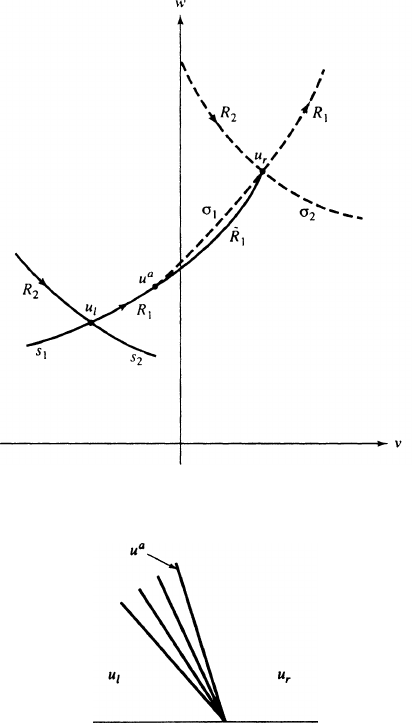
488 16. Nonlinear Hyperbolic Equations
FIGURE 7.8 Connecting u
`
to u
r
FIGURE 7.9 One-Sided Contact Discontinuity
In Fig. 7.10, we take the case illustrated by Fig. 7.8 and relabel the old u
r
as
u
m
,takinganewu
r
, connected to u
m
by S
2
[
e
S
2
, consisting of the shock curve
out of u
m
, continued beyond the vertical axis until the Lax shock condition fails,
at u
b
, and then followed by the flow-out from u
b
under R
2
.
The resulting solution to the Riemann problem is depicted in Fig. 7.11.First
we have the 1-rarefaction connecting u
`
to u
a
, followed by the jump disconti-
nuity connecting u
a
to u
m
,asinFig.7.9. Then we have the jump discontinuity
connecting u
m
to u
b
, satisfying the shock/contact condition
(7.91)
2
.u
m
/<sD
2
.u
b
/:
Finally, u
b
is connected to u
r
by a 2-rarefaction.
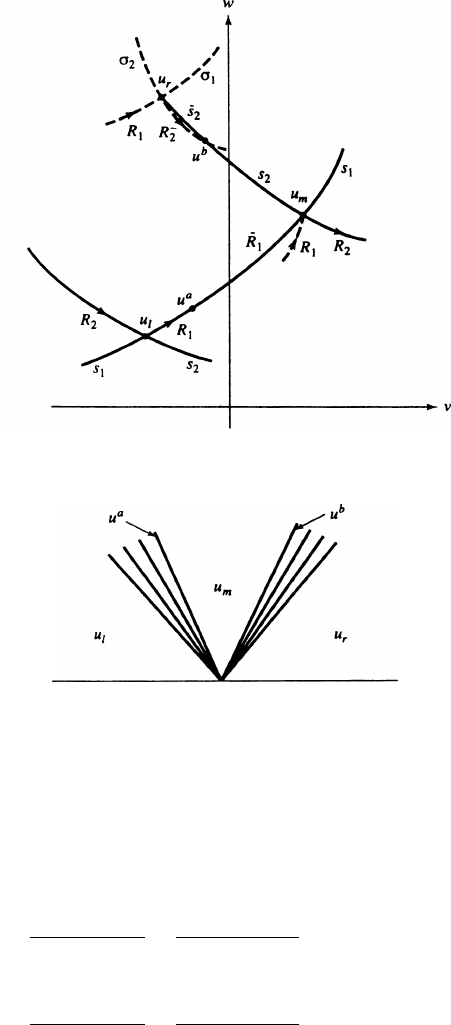
7. Systems of conservation laws in one space variable; Riemann problems 489
FIGURE 7.10 Connecting u
`
to u
r
FIGURE 7.11 Two One-Sided Contacts
Figures 7.9 and 7.11 should remind one of Fig. 6.7, depicting the solution to a
Riemann problem for a scalar conservation law, satisfying Oleinik’s condition (E).
In fact, it can be verified that the discontinuities produced by the construction
above satisfy the following admissibility condition. Say a weak solution to (7.85)
is equal to .v
`
;w
`
/ for x<stand to .v
r
;w
r
/ for x>st;t 0. Then the
admissibility condition is that, for all v between v
`
and v
r
, either
(7.92)
K.v/ K.v
`
/
v v
`
K.v
r
/ K.v
`
/
v
r
v
`
.if s 0/;
or
(7.93)
K.v/ K.v
`
/
v v
`
K.v
r
/ K.v
`
/
v
r
v
`
.if s 0/:
Compare this to the formulation (6.48) of condition (E).

490 16. Nonlinear Hyperbolic Equations
In [Liu1] there is a treatment of a class of 2 2 systems, containing the case
just described, in which an extension of condition (E) is derived. See also [Wen].
This study is extended to n n systems in [Liu2].
Further interesting phenomena for the Riemann problem arise when there is
breakdown of strict hyperbolicity. Material on this can be found in [KK2, SS2],
and in the collection of articles in [KK3]. We will not go into such results here,
though some mention will be made in 10.
In addition to solving the Riemann problem when u
`
and u
r
are close, one also
wants solutions, when possible, when u
`
and u
r
are far apart. There are a number
of results along these lines, which can be found in [DD,KK1,Liu2,SJ]. We restrict
our discussion of this to a single example.
We give an example, from [LS], of a strictly hyperbolic, genuinely nonlinear
system for which the Riemann problem is solvable for arbitrary u
`
; u
r
2 ,but
some of the solutions do not fit into the framework of Proposition 7.1. Namely,
consider the 2 2 system (7.5)–(7.6) describing compressible fluid flow, for u D
.v; /, with Df.v; / W >0g. As seen in (7.10), if we switch to .m; /-
coordinates, with m D v, then there are eigenvalues
˙
D m= ˙
p
p
0
./
and eigenvectors R
˙
D @=@ C
˙
@=@m. Thus integral curves of R
˙
satisfy
P D 1; Pm D m= ˙
p
p
0
./; hence
Pv D
Pm m P
2
D˙
p
p
0
./
;
that is, integral curves of R
˙
through .v
`
;
`
/ are given by
(7.94) v v
`
D˙
Z
`
p
p
0
.s/
s
ds D˙
p
A
Z
`
s
.3/=2
ds:
If 2 .1; 2/,asassumedin(7.6), then these rarefaction curves intersect the axis
D 0. Note that if we normalize R
˙
so that R
˙
˙
D 1,then
(7.95) R
˙
D
A
3
3
1=2
"
p
p
0
./
@
@v
˙
@
@
#
:
Furthermore, specializing (7.58), we see that the shock curves from u
`
are
given by
(7.96) v v
`
D
`
`
p./ p.
`
/
1=2
; for ˙ .
`
/ > 0:
Note that these shock curves never reach the axis D 0.SeeFig.7.12 for a picture
of the shock and rarefaction curves emanating from u
`
.
Now, as in Fig. 7.13,picku
0
D .v
0
;
0
/ 2 and consider the “triangular”
region T , with apex at u
0
, bounded by the integral curves of R
(forward) and
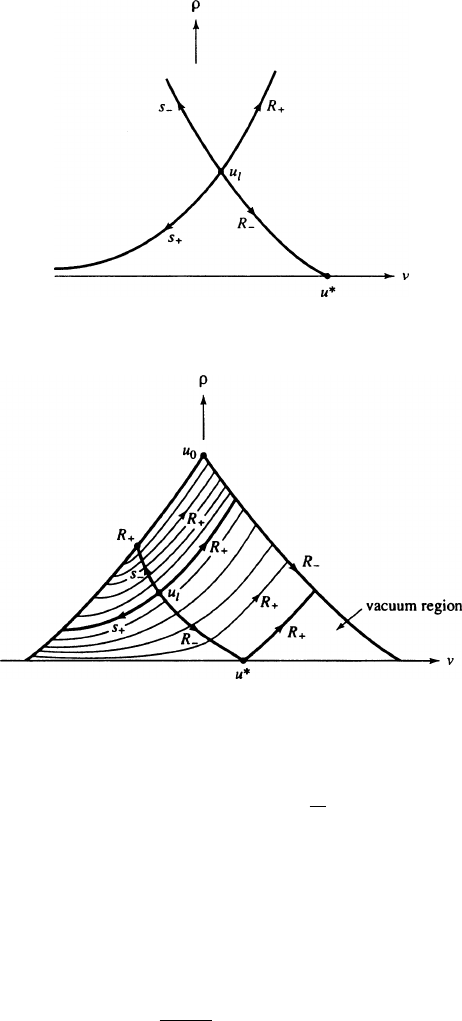
7. Systems of conservation laws in one space variable; Riemann problems 491
FIGURE 7.12 Shock and Rarefaction Curves Through u
`
FIGURE 7.13 Vacuum Region
of R
C
(backward) through u
0
, and by the axis D 0. This is a bounded region.
Given any u
`
; u
r
2 T , we will produce a solution to the Riemann problem, whose
intermediate state also belongs to T (oratleastto
T ).
In fact, as seen in Fig. 7.13,ifu
`
2 T , the rarefaction and shock waves de-
scribed before suffice to do this for u
r
in all of T except for a smaller triangular
region in the lower right corner of T , which we call the “vacuum region.” This
is bounded by part of @T , plus part of the integral curve of R
C
emanating from
u
,whereu
is the point of intersection of the R
-integral curve through u
`
with
f D 0g.
What we do if u
r
belongs to this vacuum region is indicated in Figs. 7.14 and
7.15. Namely, u
`
is connected to the vacuum by a rarefaction wave, whose speed
on the left is
.u
`
/ D v
`
p
p
0
.
`
/ and whose speed on the right is
.u
/ D
.v
;0/ D v
(since p
0
.0/ D 0 when (7.6) holds). Next, if u
a
D .v
a
;0/is the
point on the axis f D 0g from which issues the R
C
-integral curve through u
r
,
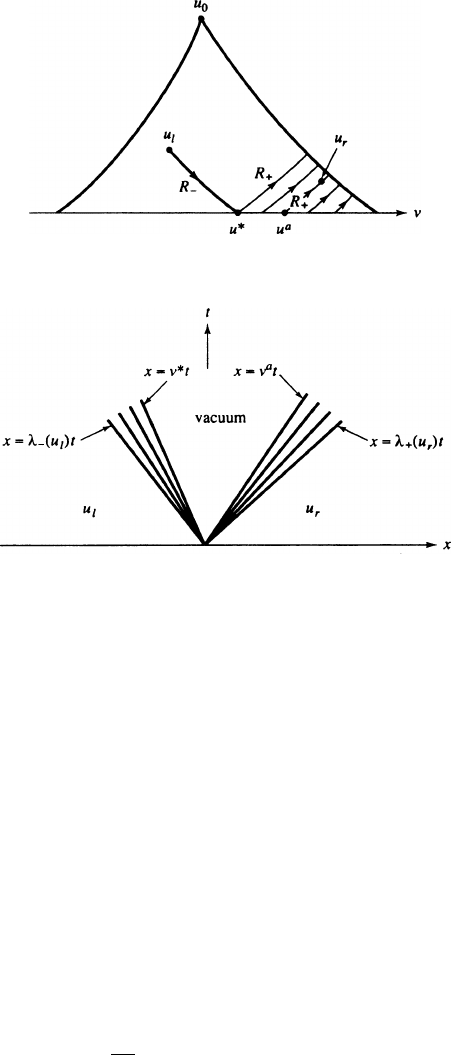
492 16. Nonlinear Hyperbolic Equations
FIGURE 7.14 Connecting u
`
to u
r
Through the Vacuum
FIGURE 7.15 Associated Solution to the Riemann Problem
then the vacuum is connected to u
r
by a rarefaction wave whose speed on the left
is
C
.u
a
/ D v
a
>v
(if u
a
¤ u
) and whose speed on the right is
C
.u
r
/.Inthe
special case that u
a
D u
, the vacuum state disappears, except for a single ray,
along which the two rarefaction waves fit together.
This concludes our discussion in this section of examples of the Riemann prob-
lem. In 10 there is further discussion for equations of vibrating strings.
Continuing a theme from 6, we next explore the relation between the shock
condition (7.52) and the possibility that the solution u is a limit as " & 0 of
solutions to
(7.97) @
t
u
"
C @
x
F.u
"
/ D "@
2
x
u
"
:
Here, we will look for solutions to (7.97) of the form
(7.98) u
"
.t; x/ D v
"
1
.x ct/
:
This satisfies (7.97) if and only if
(7.99)
d
d
F.v/ cv./
D v
00
./;
7. Systems of conservation laws in one space variable; Riemann problems 493
or equivalently, if and only if there exist b 2 R
L
such that
(7.100) v
0
./ D F.v/ cv b D ˆ
cb
.v/:
In other words, v./ should be an integral curve of the vector field ˆ
cb
.There-
quirement that the limit u.t; x/ satisfy the Riemann problem (7.17) is equivalent to
v.1/ D u
`
;v.C1/ D u
r
:(7.101)
Consequently, u
`
and u
r
should be critical points of the vector field ˆ
cb
, con-
nected by a “heteroclinic orbit.” If this happens, we say u
`
is connected to u
r
via
a “viscous profile.”
For u
`
and u
r
to be critical points of ˆ
cb
, we need
(7.102) F.u
`
/ cu
`
D b D F.u
r
/ cu
r
;
hence
(7.103) F.u
r
/ F.u
`
/ D c.u
r
u
`
/:
This is precisely the Rankine–Hugoniot condition (7.29), with s D c. Now, con-
sider the behavior of the vector field ˆ
cb
near each of these critical points. The
linearization near u
0
D u
`
or u
r
is given by
(7.104) V.u
0
C v/ D
A.u
0
/ s
v:
Now, if (7.52) holds (i.e.,
j
.u
r
/<s<
j
.u
`
/), and if u
r
and u
`
are sufficiently
close, then A.u
`
/ s has L .j 1/ positive eigenvalues and j 1 negative
eigenvalues, while A.u
r
/s has Lj positive eigenvalues and j negative eigen-
values.
The qualitative theory of ODE guarantees the existence of a heteroclinic orbit
from u
`
to u
r
(if they are sufficiently close). We will not give the proof here, but
confine our discussion to a presentation of Fig. 7.16, illustrating the 2 2 case
in which u
`
is connected to u
r
by a 1-shock. The ODE theory involved here has
been developed quite far, in order also to investigate cases where u
`
and u
r
are not
close but can still be shown to be connected by a viscous profile. The book [Smo]
gives a detailed discussion of this.
We mention a variant of the viscosity method described above, which was used
in [DD]. Namely, we look at a family of solutions to
(7.105) @
t
u
"
C @
x
F.u
"
/ D "t @
2
x
u
"
of the form
(7.106) u
"
.t; x/ D v
"
.t
1
x/;
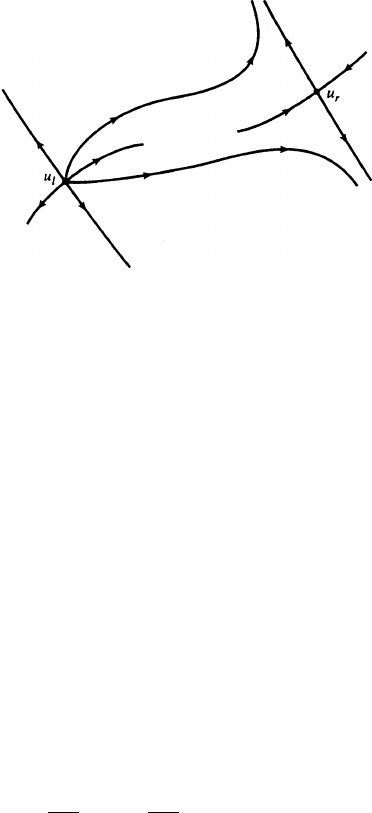
494 16. Nonlinear Hyperbolic Equations
FIGURE 7.16 Forcing a Heteroclinic Orbit
where v
"
./ solves
(7.107) "v
00
"
./ D
A.v
"
/
v
0
"
./;
and
(7.108) v
"
.1/ D u
`
;v
"
.C1/ D u
r
:
Setting w
"
./ D v
0
"
./,wegeta.2L/.2L/ first-order system for V
"
D .v
"
;w
"
/:
(7.109) V
0
"
./ D ‰
; V
"
./
D
w
"
./; "
1
ŒA.v
"
/ w
"
./
;
with
(7.110) V
"
.1/ D .u
`
;0/; V
"
.C1/ D .u
r
;0/:
The paper [DD] considered such solutions when (7.1)isa2 2 system, satisfying
(7.111)
@F
1
@u
2
<0;
@F
2
@u
1
<0; 8 u 2 R
2
;
a condition that guarantees strict hyperbolicity. In particular, it is shown in [DD]
that this viscosity method leads to a solution to the Riemann problem for all data
.u
`
; u
r
/ whenever (7.1) is a symmetric hyperbolic 22 system, satisfying (7.111).
We mention another “viscosity method” that has been applied to 2 2 systems
of the form (7.14). Namely, for ">0, consider
(7.112)
v
t
w
x
D 0;
w
t
K.v/
x
D "v
xt
:

7. Systems of conservation laws in one space variable; Riemann problems 495
This comes via v D u
x
;wD u
t
, from the equation
(7.113) u
tt
K.u
x
/
x
D "u
xxt
;
which arises in the study of viscoelastic bars; see [Sh1]and[Sl]. We look for
a traveling wave solution U D .v; w/ of the form U
.x st/="
, satisfying
U.1/ D .v
`
;w
`
/; U.C1/ D .v
r
;w
r
/. Thus we require
(7.114)
s.v v
`
/ .w w
`
/ D 0;
s.w w
`
/
K.v/ K.v
`
/
Dsv
0
./;
hence
(7.115) sv
0
./ D K.v/ K.v
`
/ s
2
.v v
`
/I v.1/ D v
`
;v.C1/ D v
r
:
For this to be possible, one requires that .v/ D K.v/ K.v
`
/ s
2
.v v
`
/
vanish at v D v
r
as well as v D v
`
; this together with the first part of (7.114)
constitutes precisely the Rankine–Hugoniot condition, that
e
U D .v
`
;w
`
/ for x<
st; .v
r
;w
r
/ for x>st;t 0, be a weak solution to (7.14). In addition, in order to
solve (7.115), one requires that v
`
be a source for the vector field .sgn s/ .v/@=@v
on R,thatv
r
be a sink, and that there be no other zeros of .v/ for v between v
`
and v
r
. Thus we require
K.v/ K.v
`
/
v v
`
s
2
>0;
for v between v
`
and v
r
< if s>0, and the reverse inequality if s<0. Note that
this implies the admissibility condition (7.92)–(7.93),given that K.v
r
/K.v
`
/ D
s
2
.v
r
v
`
/. See the exercises after 8 for more on this viscosity method.
There is a method for approximating a solution to (9.1) with general initial
data, via solving a sequence of Riemann problems, called the Glimm scheme,after
[Gl1], where it is used as a tool to establish the existence of global solutions for
certain classes of initial-value problems. The method is the following: Divide the
x-axis into intervals J
of length `. In each interval J
, pick a point x
, at random,
evaluate u.0; x
/ D a
, and now consider the piecewise-constant initial data so
obtained. Assuming, for example, that (8.1) is strictly hyperbolic and genuinely
nonlinear, and ju.0; x/jC , one can obtain for small h a weak solution v.t; x/ to
(8.1)on.t; x/ 2 Œ0; h R, consisting locally of solutions to Riemann problems;
see Fig. 7.17. Now, pick a new sequence y
of random points in J
,evaluate
v.h; y
/ D b
, and repeat this construction to define v.t; x/ for .t; x/ 2 Œh; 2h
R. Continue. In [Gl1] there are results giving conditions under which one has
v D v
`;h
well defined for .t; x/ 2 R
C
R, and convergent to a weak solution as
` ! 0; h D c
0
`. Further results can be found in [GL, DiP1, Liu5]; see also the
treatment in [Smo]. In 9 we will describe a different method, due to [DiP4], to
establish global existence for a class of systems of conservation laws.
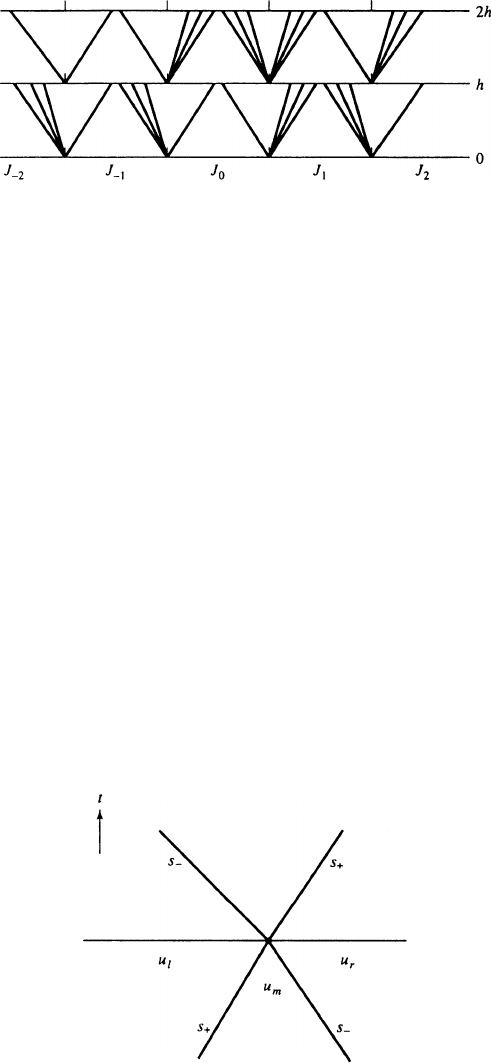
496 16. Nonlinear Hyperbolic Equations
FIGURE 7.17 Setup for Glimm’s Scheme
Exercises
In Exercises 1–3, we consider some shock interaction problems for a system of the
form (7.1). Assume (7.1)isa2 2 sysyem, strictly hyperbolic and genuinely nonlinear.
Assume u
`
and u
r
are sufficiently close together.
1. Suppose that, for t<t
0
; u takes three constant values, u
`
; u
m
; u
r
, in regions separated
by shocks of the opposite family, with shock speeds s
C
;s
. Assume the faster shock is
to the left. Thus these shocks must intersect; say they do so at t D t
0
(see Fig. 7.18).
Show that the solution to the Riemann problem at t D t
0
, with data u
`
; u
r
, consists
of two shocks, s
;s
C
, as depicted in Fig. 7.18. In particular, there are no rarefaction
waves.
2. Suppose that, for t<t
0
; u takes on three constant values u
`
; u
m
; u
r
, in regions sepa-
rated by shocks of the same family, say s
C
, and assume that the left shock has higher
speed than the right shock. Thus these two shocks must intersect; say they do so at
t D t
0
(see Fig. 7.19). Show that the solution to the Riemann problem at t D t
0
, with
data u
`
; u
r
, consists of a shock of the same family as those that interacted, together
(perhaps) with either a shock wave or a rarefaction wave of the other family. (Hint:
Study Fig. 7.4.)
If only the second possibility can occur when two shocks of the same family collide,
the 2 2 system is said to satisfy the “shock interaction condition.” This condition was
introduced by Glimm and Lax; see [GL].
3. Show that the shock interaction condition holds, at least for sufficiently weak shocks,
provided that D R
2
and, for each u
`
2 , the curves '
1
.u
`
I/ and '
2
.u
`
I/ are
FIGURE 7.18 Situation for Exercise 1
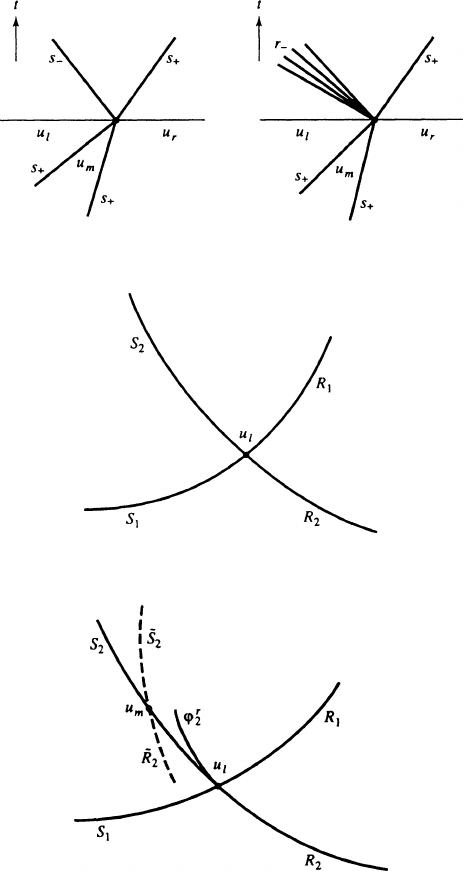
Exercises 497
FIGURE 7.19 Situation for Exercise 2
FIGURE 7.20 Situation for Exercise 3
FIGURE 7.21 Possible Attack on Exercise 3
both strongly convex, as in Fig. 7.20. Here, '
j
.u
`
I/ is obtained by piecing together
the rarefaction curve '
r
j
.u
`
I/ and the shock curve '
s
j
.u
`
I/.(Hint: Show that if, for
example, u
m
lies on the 2-shock curve from u
`
,asinFig.7.21, then the 2-wave curve
'
2
.u
m
I/ D
e
S
2
[
e
R
2
is as pictured in that figure, as is the continuation of '
r
2
.u
`
I/
for <0. To do this, you will need to look at @
3
'
j
.u
`
I˙0/.See[SJ].)
